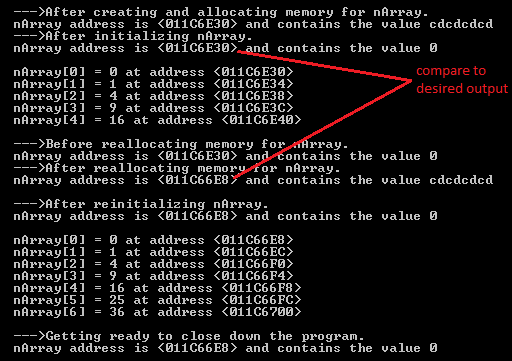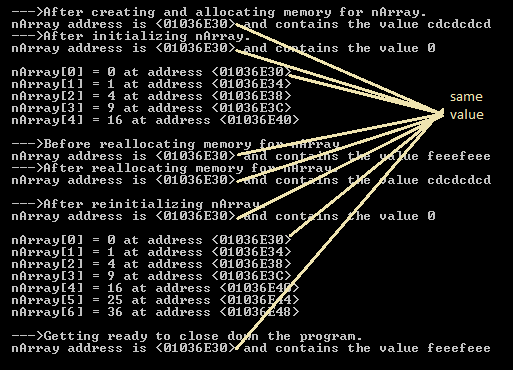Question
2. Problems With Pointers and New / Delete (TCOs 2, 4, 5, and 6) The following code creates a pointer to an array of ints
2. Problems With Pointers and New/Delete (TCOs 2, 4, 5, and 6)
The following code creates a pointer to an array of ints and allocates space for five ints. It then loads the array with the square of values 0 through 4 and displays the results. Because this is a dynamic array allocation, we can reallocate a larger array. This time we allocate space for seven ints and load and display the squares. In the process, our code has created a memory leak, because we failed to follow the hard and fast rule of for every new there must be a delete. When you run this program (before you fix the memory leak), the output should look something like the following.

Figure 1: Memory Leak Output
Heres a printout of what the values should be. The actual addresses, of course, will be different, but they should follow the same pattern.

Figure 2: Desired Output
Notice in Figure 1 that the address of nArray never changes and is the same for nArray[0] in both loops.
For this assignment, fix the memory leak. The output should look similar to Figure 2.
Here is the code.
// Week 2 Assignment-2
// Description: Problems with pointers and new/delete
//----------------------------------
//**begin #include files************
#include // provides access to cin and cout
//--end of #include files-----------
//----------------------------------
using namespace std;
//----------------------------------
//**begin global constants**********
const int arraySize = 5;
//--end of global constants---------
//----------------------------------
//**begin main program**************
int main()
{
cout
int* nArray = new int[arraySize];
cout After creating and allocating memory for nArray."
cout and contains the value "
for (int i = 0; i
{
nArray[i] = i*i;
}
cout After initializing nArray."
cout and contains the value "
for (int i = 0; i
{
cout "
}
// You'll need a command here to fix the memory leak
cout Before reallocating memory for nArray."
cout and contains the value "
nArray = new int[arraySize + 2];
cout After reallocating memory for nArray."
cout and contains the value "
for (int i = 0; i
{
nArray[i] = i*i;
}
cout After reinitializing nArray."
cout and contains the value "
for (int i = 0; i
{
cout "
}
// . . . and also here.
cout Getting ready to close down the program."
cout and contains the value "
// Wait for user input to close program when debugging.
cin.get();
return 0;
}
//--end of main program-------------
//----------------------------------
After creating and allocating memory for nArray. Array address is 4011C6 E30> and contains the value o dodcdod After initializing nArray Array address is Before reallocating memory for ATArray. Array address is 4011C6E30 and ontains the value 0 After reallocating memor or Array Array address is 4011C6 6E8 and contains the value cdcdcdcd After reinitializing nArray Array address is 4011C66E8 and contains the value Array CO1 0 at address 4011 C66E8 Array[11 1 at address 4011 C66EC Array[21 4 at address 4011 C66F0 nArray[3 1 9 at address 4011 C66F4 Array D41 16 at address 4011 C66F8 Array[51 25 at address 4011 C66FC n Array[61 36 at address 4011C6700 >Getting ready to close down the program Array address is 4011C66E8 and contains the value 0
Step by Step Solution
There are 3 Steps involved in it
Step: 1

Get Instant Access to Expert-Tailored Solutions
See step-by-step solutions with expert insights and AI powered tools for academic success
Step: 2

Step: 3

Ace Your Homework with AI
Get the answers you need in no time with our AI-driven, step-by-step assistance
Get Started


